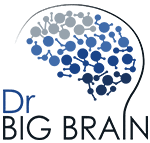Neurofeedback FAQ
Neuroplasticity is the ability of the brain to adapt to changes in an individual's environment by forming new neural connections over time. Neuroplasticity explains how the human brain is able to adapt, master new skills, store memories, and information and even recover after a traumatic brain injury.
Neurofeedback has a high rate of success with many conditions, particularly Anxiety/Depression and ADD/ADHD, and significant success rates with other conditions. Dr Big Brain helps both adults and children (over the age of six), dealing with many brain imbalance conditions. The best way to determine if Neurofeedback will help you is a consultation with the provider at Dr Big Brain. You’ll be able to talk about what you’ve been experiencing and learn how this process may help you. Since each patient is unique, the provider may recommend an initial brain scan, or Quantitative Electroencephalogram (qEEG), to determine if this beneficial program will help you feel better and eliminate or drastically reduce your symptoms, helping you return to the life that you enjoy! This scan will produce a map of your brain, indicating if irregular brainwave patterns exist, and will assist in determining if Neurofeedback is the best option for you. In addition, a customized nutritional program may be recommended for your condition to further accelerate recovery to the life that you want return to.
Neurofeedback is used to restore the brain to a healthier pattern and provides relief for patients suffering from Anxiety, Depression, OCD, ADD, ADHD, PTSD, chronic pain, chronic migraine headaches, Insomnia, and more. In addition to these conditions, neurofeedback has been making recent headlines as a treatment for Traumatic Brain Injury and Autism/Spectrum disorders. While Neurofeedback is often used to assist those suffering from a wide range of medical conditions, it is also used to improve performance, enhance clarity and attain desired outcomes. Athletes, scholars, and other experts in their fields use Neurofeedback as a way to optimize their brains, so they may achieve peak performance.
In over four decades, there have been very few reported side effects and Neurofeedback is considered safe for all patients.
Since Neurofeedback works to train your brain to make effective connections and create positive changes, the results last. Completing Neurofeedback is like learning any other skill – from riding a bicycle to swimming or knitting, once you acquire the skill you will retain it. Some patients do like to return and review on a regular basis – pediatric patients who are constantly experiencing growth and change may need to return occasionally, just as they return to a doctor, speech therapist, or physical therapist, as gains are made.
Neurofeedback is a type of biofeedback; it is designed to specifically target brainwave patterns. Other forms of biofeedback may target and regulate other body parts and functions, from blood pressure to heart rate.
Once we have your personal brain map and the details about what you are experiencing, we compare your qEEG/brain map with our extensive normative database to see which specific areas of your brain need to be rebalanced. We use this data to craft a customized program and training session schedule designed specifically for you.
Neurofeedback will not change your personality – it will simply train your brain to work more effectively and enhance your overall mental balance and mood. Most people feel calmer, less stressed, and better able to focus after beginning Neurofeedback, but the process does not change your core personality, beliefs, or memory.
Also called EEG biofeedback or Neurotherapy, neurofeedback uses technology to identify patterns and irregularities within the brain. Once a pattern or issue is detected, it frequently may be modified, using audio and visual cues to change timing and activation patterns in the brain. Neurofeedback does not target any condition, but instead slowly guides your brain back to normal ranges, allowing your brain to return to a healthier pattern. Over time, this process of finding and correcting irregularities can help ease issues associated with a variety of conditions, resulting in relief without drugs or chemical intervention. Neurofeedback is not new; it has been used for decades to help patients with a wide range of diagnoses and issues and continues to improve and evolve.
There is currently no insurance coverage for neurofeedback therapy. We have financing options to make this life-changing therapy available and affordable through Advance Care.
